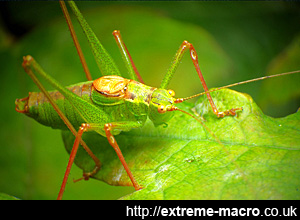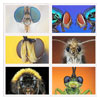Insect Photography
by Johan J Ingles-Le Nobel
Last updated August 31, 2017
Insects are the largest group of animals on earth by far: about 926,400 different species have been described to date.
For every one of us, there are around 1.5 billion insectsEstimates of the total number of species range from 2 million to 30 million; estimates of the total number of actual insects in the world usually end up round the 10,000,000,000,000,000,000 mark. For every one of us, there are around 1.5 billion insects. Insects are predominantly small, with details hidden from view, and given their ubiquitous nature, it is no surprise that insects are the subjects of many extreme macro photographs.
Finding Insects
it can actually be surprisingly tricky to find insects for photographyWith so many insects around, it can actually be surprisingly tricky to find insects for photography. The entomological world is the obvious place to look, and there are a variety of tradecraft techniques to up your success rate. Look for insects early in the morning and/or near water for the greatest number, and for a surprising selection, go out with a torch at night. It's really easy to up your game in the garden by planting certain plants and trees. To photograph insects at night, all you need is a horizontal setup with a torch attached.

Insects - there are billions of billions of them about, but whenever you want to go and photograph one you can never seem to find them. The insect season really starts in March and finishes in October in the UK, and during the winter months is a good time to take out your collected specimens to try some focus stacking.
Catching Insects
Of course there are also other ways to find insects, by using the traditional insect traps that have been used in entomology for a long time. A classic sweep net is used on meadows, bushes and smaller plants, and a pitfall trap can easily be added to any domestic garden. See what's flying at night with a mercury vapour moth trap, and enliven those summer afternoons by putting out a tropical butterfly trap. Beating for insects is a bit more laborious but gets you the species that you won't normally see using other methods.
Specimen Preparation Walkthrough
1 ➤ The specimen preparation workflow
2 ➤ How to clean preserved specimens
3 ➤ How to relax specimens for spreading
4 ➤ How to make spread specimens for setting
5 ➤ How to cure dehydrated eyes
6 ➤ How to dry a cured specimen fast
7a ➤ How to pin a cured specimen, or...
7b ➤ How to card a cured specimen
Other reading: focus stacking walkthrough
Posing Insects
This is the hardest part of a focus stacked photograph from me but there's plenty of help available from the world of entomology. Mounting insects takes skill and patience, and cleaning bugs for photography really is one of the banes of our lives, although there is apparatus that can help. Start off by relaxing insects and spreading, then achieve the perfect pose by carding and finally pinning insects. Part of the process of photographing an insect for a focus stack may also be to restore the insect.
Insects And Photography
enliven those summer afternoons by putting out a tropical butterfly trapSometimes we kill specimens in order to photograph them, and typically we'll either freeze them or use chemicals designed for entomology. This isn't great and I'm personally working on an insect chilling chamber to hopefully avoid this. But to put it into context, killing a handful of specimens a year is the tiniest of numbers. Consider this:
In May 2011, Dutch biologist Arnold van Vliet embarked on a bold and buggy mission to count how many insects are killed by cars -- and six weeks later, the results are in. To perform the census of bug vs. car fatalities, the researcher enlisted the help of around 250 drivers to count the number of squashed insects on their front licence plates per distance travelled. After some simple math, van Vliet has arrived at a figure that is nothing short of astronomical. With the help of volunteer squished-insect-counters submitting data to a web site devoted to the dead bug census, SplashTeller, biologists have learned a bit more about how deadly driving can be. All told, over the course of six weeks and 19,184 miles of travel, the smooshed bodies of no less than 17,836 insects were discovered -- on the cars' front licence plates alone. That averages to two insects killed (in that particular area of the vehicle) for every 6.2 miles traveled. With 200 million cars in the US, driven an average of 12,500 miles per year, the entire nation travels approximately 2.5 trillion miles annually, and kills around 32.5 trillion insects in the process.
What Is An Arthropod?
An arthropod is an invertebrate animal having an exoskeleton (external skeleton), a segmented body, and jointed appendages. Arthropods are members of the phylum Arthropoda and include the insects, arachnids, and crustaceans. An arthropod is a member of either spiders, scorpions, insects, and other groups. Insects are also arthropods but are the arthropods with 6 legs. Others like arachnids have 8 legs. Arthropod is a handy term in extreme macro because it includes spiders and insects, both of which we photograph often.
What is an Insect?
Adult insects have six legs, three on each side of their bodies. Each insect's body has three main parts: a head, a thorax, and an abdomen. Insects also have one pair of antennae in front of the head. Many insects have one or two pairs of wings. Spiders have eight legs, and are not insects. The close relative of the spider, the scorpion, also has eight legs. It is not an insect either. Neither are the many-legged centipede and millipede.
What Is A Bug?
The term bug is correctly used only for one order of insects, the Hemiptera, or true bugs (also called Heteroptera). This order includes bedbugs, stinkbugs, assassin bugs and several others. True bugs have a stylet (a mouth shaped like a straw) that they use to suck plant juices from plants. Assassin bugs use their stylets to suck blood from other insects. In common use though, especially in the US, bug is a generic term for any insect or similar creeping or crawling invertebrate, or even bacteria. It is an oft-used term, but not a correct scientific term. Bug, ie walking invertebrate, is often used when arthropod should be used.
Downloads
Related Articles





